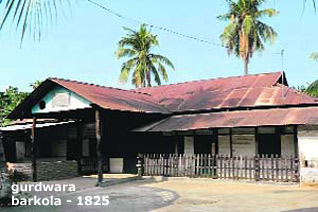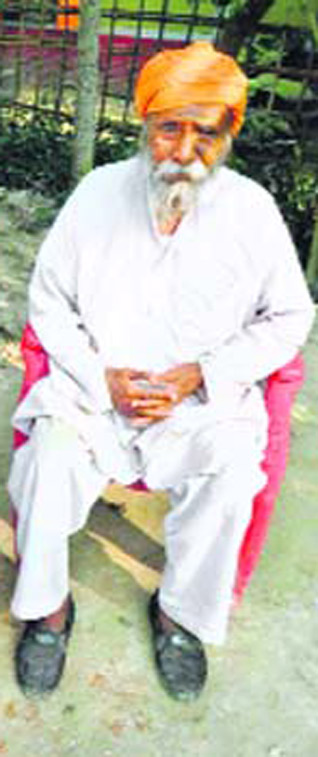History
Axomiya Sikhs:
The Two-Century Old Sikh Settlement in Assam
BIRINDER PAL SINGH
The Sikhs living in Assam, a state in the eastern part of India, are the progeny of soldiers sent two centuries ago by the 19th century Sikh Emperor, Maharaja Ranjit Singh, to support the Ahom king, Chandrakanta Singha.
Chaitanya Singh, the commander of Maharaja Ranjit Singh's soldiers, was a brave soldier who died fighting valiantly at Hadira Chauki. Their defeat and the loss of many soldiers sent the survivors into hiding. His wife, the revered Mata Ji, along with trusted men, finally settled at Chaparmukh.
Mata ji's gurdwara was constructed in 1820. Showcased here are her chakki (grinders) and a sword as relics, besides two guns.
Axomiya Sikhs, as they are called, have immersed themselves in the local culture. Many among them no longer speak Punjabi. Their main occupation is agriculture. Barkola, Chaparmukh and Lanka, all in the district of Nagaon, are their major settlements.
It goes to their credit that some of them have excelled in literature.
Nand Singh, a police officer, is an established writer with 15 books of short story and poetry to his credit. He bagged the Sahitya Akademi Award in 2012 for contribution to Axomiya literature. He has a CD of his poems sung by a noted singer.
Bhupinder Singh, a former principal of a college, is busy translating Sikh banis.
Their assimilation into Assamese culture is a consequence of inter-marriages with local women, both tribal and non-tribal. Couples partake in the Khalsa Amrit initiation, though observance of the discipline is quite lax.
These Sikhs are distinct from those who have migrated over the past three or more decades for business, especially in the transport sector. The “new” arrivals are called Punjabi Sikhs in local parlance. Social relations between the two are manifestly cordial but some tensions have started surfacing.
The Punjabi Sikhs are condescending towards Axomiya Sikhs (despite the Khalsa form) due to their poverty and ignorance of Punjabi -- as they say: "Eh keho jihe Sikh ne, Punjabi nahin jaande".
But the latter have laid their lives in the Assam movement. Of the three youth of Barkola killed, two were Sikhs. A memorial to them is under construction.
These Sikhs are cut off from Punjab both socially and culturally, but are ever willing to visit the Harmandar Sahib. A jatha is reported to have travelled to Punjab in 2008.
Barkola is a large village where stands the old Central Gurdwara (1825), now overshadowed by the new one. It has the largest Sikh population in rural Assam. All of them had land to till but now a few households have become landless. Quality gur (jaggery) is made from the sugarcane of this area.
An anthropological study of Barkola earned Dr. Medhi his Ph.D. degree in 1989.
Dhubri is another place of religio-historical interest for Sikhs.
Guru Nanak, followed by Guru Tegh Bahadar, visited Dhubri.
When Guru Tegh Bahadar was camping there, Ram Singh, commander of Aurangzeb's forces, came to seek his blessings. The Guru mediated a peace between him and the Ahom ruler. Later, he asked each soldier to put five shieldloads (dhaal) of sand on the banks of the Brahmaputra, the place where the gurdwara is located.
Looking at the river's might, one wonders how the Guru internalised its opposite. "Darya da bahao, Guru da thhehrao", is an apt formulation.
Adjoining the gurdwara stands a large tilted stone. Legend has it that it was hurled at the Guru. The local king had obtained the services of a dhoban (washerwoman) for his mischief. When her attempt failed and she realized the power of his spirituality, she fell at the Guru’s feet.
The Guru blessed her: "tohe naam par nagar vasayun", hence the name Dhubri. Sikhs from all over the North-East congregate here on Guru's Shaheedi Gurupurab.
There is another category of Sikhs who have been living in Guwahati / Dispur and Shillong for about 100 years and have maintained their Majhaili dialect and intonation. Born and brought up there, they keep Gurdaspur and Amritsar alive in their lives, and all of them marry their children here. That is why they are strongly rooted and often visit Punjab with their families. It is only a few who have not visited their native place since birth. They are mostly impoverished, however, and live in poverty.
They are often threatened with eviction. The city administration has an eye on the prime land they occupy. They protest and fight, but do not want to go far from their work place, which is the government offices where they work as safai karmacharis. At Morakhali, the Guwahati Municipal Corporation, has constructed two multiple-storey blocks at the same place. But those at Dispur and Shillong are not that fortunate.
The Shillong Municipal Corporation too has similar plans but the residents fear that after being been uprooted, they would be thrown out. Altercations take place between them and those of the native Khasi tribe on one pretext or another and they confront them with swords.
A senior officer confided, "Besides the dismal living conditions, gambling and trafficking that they indulge in also pose a threat to law and order. The police are scared to enter that area." The political ding-dong continues.
[Courtesy: Tribune. Edited for sikhchic.com]
March 24, 2013
Conversation about this article
1: Kanwarjeet Singh (USA), March 24, 2013, 12:08 PM.
I am sorry but is it just me that thinks that is an extremely poorly written article. There seems to be no flow to information and no central point of focus. Perhaps the author needs to describe what this piece / news is centred around and what he is trying to communicate. Would also be good to know what the cause of friction is between the Khasi and Sikh-Assamese, and between the latter and the recent Sikh-Punjabi arrivals.
2: Bhai Harbans Lal (Dallas, Texas, USA), March 29, 2013, 1:58 PM.
According to traditional Sikh history, the whole state of Assam accepted Sikhi as their religion during the visit of Guru Tegh Bahadar, including the king of the area. It is our fault that we began to define Sikhs based on Punjabi ethnicity that ignores Sikhs from other ethnic and cultural groups. Thus with time we lose them unless replenished by Punjabi stock. This is our fate in many parts of the world.
3: Kirpal Singh (Daytona Beach, Florida, USA), June 28, 2014, 9:05 PM.
Sikhism is now a multi-ehnic religion. We must accept each other with open arms to spread this religion worldwide.
4: Paramjit Singh Sandhu (Ottawa, Canada), December 28, 2014, 12:36 PM.
There should be better relations between Sikh-Punjabis and the Axomiya Sikhs as we all are brothers and sisters from the same parents.
5: Parminder Singh Manchanda (Guwahati, Assam, India), January 28, 2015, 9:50 AM.
It's been a really sorry state. Historical facts do prove their faith is ingrained in Sikhi and that they have retained the true identity of the teachings of our Gurus. My personal tete-a-tete with some of the high ranking officers and respected dignatries of their locality has triggered in me a great respect for these Sikh brothers and sisters who have inculcated the spiritual identity of the Sikhs in a larger context. My head hangs in shame that neither the Government or so called Sikh leaders of any form have been able to do justice to this miniscule minority community. I earnestly appeal to all my Sikh brothers and sisters to raise concern about these wonderful people who are also economically deprived, and help them become what they actually deserve to be.
6: Dr J.S. Ranyal (New Delhi, India), March 29, 2016, 9:34 AM.
The Sikhs in Assam as well as Sikligar Sikhs are needy communities among us. We should help them. I think the Punjab govt. and the S.G.P.C. should take an initiative. Arrangements should be made to provide them education facilities, at the very least.
7: Siddharth Barthakur (India), August 19, 2016, 2:47 AM.
Quite a well-written piece indeed! Many thanks to Birinder Pal Singh ji. The Axomiya Sikhs have great contributions to Assam since the time they arrived in 1820's. It was true that Ahom King Chandrakanta Singha was impressed by Sikhism when he felt it professed a highly liberal and much more disciplined and inclusive way of life than Hinduism. I would look forward to reading more such articles in the future. Thanks, once again.
8: Mukul Kathar (Guwahati, Assam, India), March 30, 2017, 5:45 AM.
Firstly, we should all celebrate that the Assamese Sikhs have been able to keep the Sikh faith alive in the area for centuries. It would be great if the community could assist them with programs to learn Gurukhi, and even open Punjabi schools in Assam. They are your brothers and sisters and need help to assimilate in the greater Sikh/Punjabi community to which they so proudly belong.






